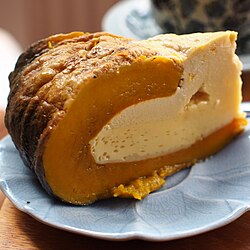
Back Sankya lapov Spanish Custard waluh klapa JV សង់ខ្យាល្ពៅ Cambodian Sekaya labu Malay สังขยา (อาหารนึ่ง) Thai Sữa trứng bí đỏ dừa Vietnamese
 A slice of pumpkin-coconut custard | |||||||
| Type | Custard | ||||||
|---|---|---|---|---|---|---|---|
| Course | Dessert | ||||||
| Place of origin | Ayutthaya Kingdom[1] | ||||||
| Region or state | Southeast Asia | ||||||
| Associated cuisine | Thai, Cambodian and Laotian cuisine | ||||||
| Created by | Maria Guyomar de Pinha[1] | ||||||
| Invented | 17th century[1] | ||||||
| Main ingredients | Coconut custard, pumpkin or kabocha | ||||||
| 1895 kcal (7934 kJ) | |||||||
| |||||||
Pumpkin-coconut custard (Thai: สังขยาฟักทอง, sangkhaya fak thong, [sǎŋ.kʰā.jǎː fák tʰɔ̄ːŋ]; Khmer: សង់ខ្យាល្ពៅ, sankhya lapov; Lao: ສັງຂະຫຍາໝາກອຶ, sangkhanya mak eu, [sǎŋ.kʰā.ɲǎ mȁːk ʔɯ́(ʔ)]; Northeastern Thai: สังขยาบักอึ, [sǎŋ.kʰā.ɲǎː bǎk ʔɯ̌(ʔ)], sangkhaya bak ue) is a Southeast Asian dessert, consisting of a coconut custard steam-baked in a whole pumpkin or kabocha. It was created by Maria Guyomar de Pinha in Ayutthaya Kingdom in 17th century as an adaptation of a Portuguese egg-based dessert.[1]
In Thailand, it is a popular dessert that is often sold in fresh food markets and as street food.[2] In Cambodia, the pumpkin-coconut custard is also sold in markets and confectionery stores often by the slice. It is the centerpiece of Cambodian New Year tables.[3] In Laos, the dessert is a very common market food as well.[4]
- ^ a b c d Van Esterik, Penny (2008). Food Culture of Southeast Asia. Greenwood Press. p. 71. ISBN 978-0-313-34419-0.
Some of the most famous Portuguese-Siamese desserts were attributed to Mary Gimard, or Thao Thong Giip Ma, the Portuguese-Japanese wife of Constance Phaulkon, the Greek adventurer who became Prime Minister under King Narai of Ayuttaya (1656–1688). She was credited with adapting Portuguese egg-based desserts into special royal desserts including a custard served in squash and a complex sweet made to look like mango seeds.
- ^ Sirinya Pakditawan (7 June 2015). "A local pumpkin delight". The Phuket News. Retrieved 31 May 2021.
- ^ Wong, Cecily; Thuras, Dylan (2021). Gastro Obscura: A Food Adventurer's Guide. Workman Publishing Company. p. 375. ISBN 978-1-523-51187-7.
- ^ Culloty, Dorothy (2010). Food From Northern Laos: The Boat Landing Cookbook. Galangal Press. p. 174. ISBN 978-0-473-17236-7.
Sang kaya mak eu, steamed egg custard in a whole pumpkin, is a dish shared with Thailand and a very common market food in Laos.